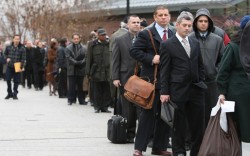- Home
- |
- About Us
- |
- Working Groups
- |
- News
- |
- Rankings
- WEF-Global Competitiveness Report
- Ease of Doing Business Report
- IMD-World Competitiveness Yearbook
- TI-Corruption Perceptions Index
- HF-Economic Freedom Index
- WEF-Global Information Technology Report
- WEF-Travel and Tourism Report
- WIPO-Global Innovation Index
- WB-Logistics Performance Index
- FFP-Fragile States Index
- WEF-Global Enabling Trade Report
- WEF-Global Gender Gap Report
- Gallery
- |
- Downloads
- |
- Contact Us
Job creation should be next president’s top priority

Economists and politicians often sing different tunes but this election season they seem to have found a common melody. They both agree that job creation should be the next administration’s top priority.
Much like the US government wants to develop direct job creation schemes with Obama’s jobs bill, which aims to reduce the 9.7-percent unemployment rate in the US, local economists and politicians also believe that joblessness here should be addressed by government.
But what should government do? Should the next administration continue deficit-spending increases to boost economic activity? Is that the long-term answer to sustainable recovery? Or does the problem call for less government activity and not more?
These are just some of the questions presidential candidates must answer in their platforms. But one thing that is unquestionable is the urgency of the situation.
According to Dr. Fernando Aldaba, former president of the Philippine Economic Society and former dean of the Ateneo de Manila University School of Economics, the Philippines needs to create 15 million jobs in five years in order to close the unemployment gap.
He based his conclusions on an eight-month study on the formulation of an industrial policy for the country by the National Competitiveness Council (NCC).
Aldaba said the country must be able to create an average of three million quality jobs a year for the next five years to be able to bridge the real unemployment gap and bring down the unemployment rate at 2 percent by the end of the fifth year.
Around 2.82 million Filipinos are totally jobless and are looking for jobs, while another 7.3 million are underemployed, those working in low-paying jobs in the services sector, Aldaba noted in his study. Then there are around 5 million returning OFWs whose contracts have ended. That totals 15.16 million Filipinos in need of jobs.
Certainly the present job creation program of government will not do. For instance, the Comprehensive Livelihood and Emergency Employment Program (CLEEP) of the National Antipoverty Commission only had an employment target of 460,280 jobs, which I am not even sure they even met last year. (CLEEP funds are sourced from the 10-percent mandatory savings of government agencies in their respective Maintenance and Other Operating Expenses budget.)
Of course, joblessness should not be the problem only of the national government. Help is vital at every level. Local governments should do their part and one thing they can do is create unemployment profiles down to the barangay level or grassroots so we can design skills programs that fit local labor markets and future demand from industries.
This would probably require funding but not much more than organization and political will. Certainly, you can put a P1.54 trillion national budget to better use.
The next administration should immediately hold a jobs forum to bring the national government, local governments, trade unions, schools, and industry councils together to find the best ways to help unemployed Filipinos find quality employment. All levels of government and the private sector need to work together to tackle joblessness and deliver tangible benefits to the country.
- Ernesto F. Herrera, Manila Times

